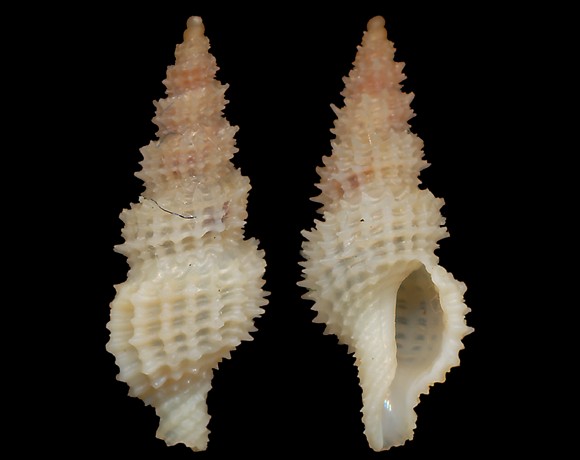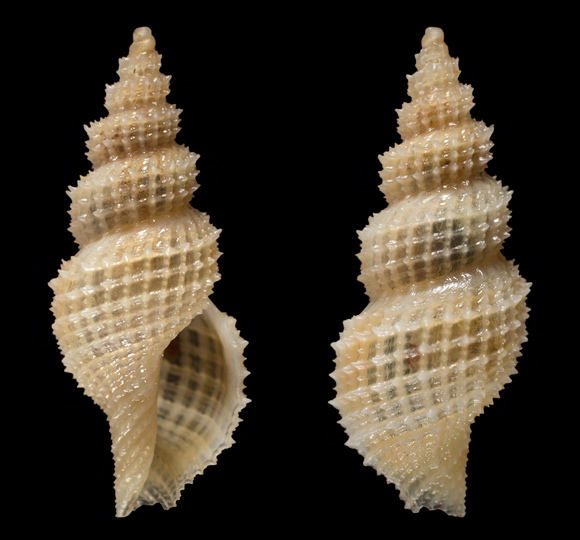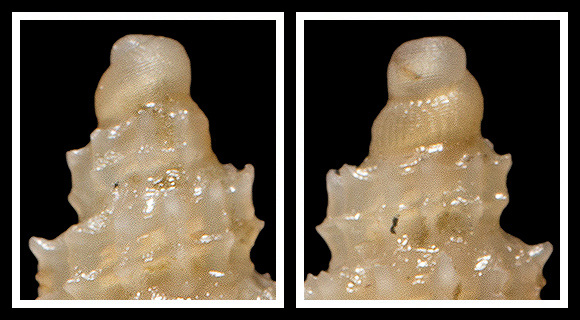
Predator in the circalittoral.
Original taxon: Clathurella pseudohystrix.
Synonym: divae Carrozza, 1984.
« As the Marquis de Monterosato, who kindly suggested the above name to me, points out, the fossil form [R. hystrix Jan] has a pointed protoconch, composed of three or four whorls; while the recent shell, in the character of its protoconch, rather resembles Trophon. Precisely where the fossil form disappeared and was replaced by the present shell, I am unable to determine, but the two appear to be distinct. » – E. Syke: “On the Mollusca procured during the ‘Porcupine’ Expeditions 1869-1870. Supplemental notes, part III”, Proceedings of the Malacological Society of London vol. VII: year 1906-1907, London 1907, p.187.
60m deep, on mud, Málaga, Andalucia, S. Spain. 10mm.

The loss of planktotrophy in the genus Raphitoma has been recently noticed. For the possible consequences in taxonomy and phylogeny, cf. Manousis & al., 2017. Nota bene that R. pseudohystrix shares with the Miocene-Pliocene R. hystrix the whole of the shell morphology, protoconch excepted: the extant pseudohystrix having a paucispiral proto, while the fossil hystrix beared a multispiral one.
Holotype MNHN-IM-2000-2902 of Raphitoma divae at the Muséum national d’Histoire naturelle de Paris, France. Original pictures provided by M. Caballer for the MNHN – (CC BY).

« Carrozza illustrates the protoconchs of R. pseudohystrix and R. divae and recognises the similarities, the only differences being a more finely regular sculpture and a less turreted shape. We consider frankly that these differences are very slight, also considering the fact that, if the two protoconchs had been reproduced with the same angulation, probably these faint differences would have even disappeared. » – Bogi, Coppini & Margelli: “Contribution to the knowledge of the malacofauna of the Northern Tyrrhenian Sea”, La Conchiglia anno XVIII (207), Roma 1986, p.29.
In his article, Carrozza notices a stronger difference between Sykes’s pseudohystrix and his divae: the numbers of axials and spirals, which are found noticeably lower in the first species than in the second. But Bogi & al.: « On the approximately 40 specimens examined, we found individuals with the number of ribs varying from 14 to 29 and the variations regarding the spiral cords is similar. All the intermediate forms are represesented in groups of about the same number, showing the extreme variability of the species […]. Due to this data, we consider that R. divae is only an extreme form of R. pseudohystrix » – Ibid.
In his article, Carrozza notices a stronger difference between Sykes’s pseudohystrix and his divae: the numbers of axials and spirals, which are found noticeably lower in the first species than in the second. But Bogi & al.: « On the approximately 40 specimens examined, we found individuals with the number of ribs varying from 14 to 29 and the variations regarding the spiral cords is similar. All the intermediate forms are represesented in groups of about the same number, showing the extreme variability of the species […]. Due to this data, we consider that R. divae is only an extreme form of R. pseudohystrix » – Ibid.